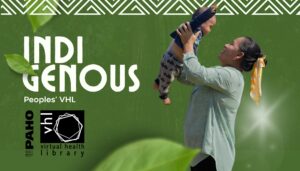In continuity with efforts to strengthen indigenous health in Latin America and the Caribbean by promoting the visibility, access and use of the scientific and technical literature produced in the region, since the beginning of 2024, BIREME/PAHO/WHO and the Special Secretariat for Indigenous Health of the Brazilian Ministry of Health (SESAI/MS) have dedicated significant efforts to advancing on the various fronts of the project. The activities take place in the context of Technical Cooperation Agreement 93, in its fourth Amendment (TA4/TC93). Below are the highlights of the project over the last six months.

1. Alignment of the work plan and holding a workshop
After two face-to-face meetings held in February and April 2024, it was possible to align the VHL Indigenous Health work plan with SESAI’s priorities, consolidating a strategic cooperation with Fiocruz. This alliance aims to integrate the initiatives of the Indigenous Health VHL and the Health of Indigenous Peoples VHL, optimizing resources and expanding the impact of the VHL throughout Brazil. Besides the teams from SESAI, BIREME, and Fiocruz, the alignment of the work plan also involved representatives from the General Coordination of Documentation and Information of Brazil’s Ministry of Health (CGDI/MS) and PAHO Brazil.
2. Setting strategic goals
Based on the integration of initiatives in favor of the Indigenous Health VHL, four strategic goals were defined, listed below. For each goal, the activities and main expected results were defined.
Goal 1 – Analysis and prospecting of innovative information technologies and methodologies aimed at improving transparency and dissemination of information and knowledge in the area of indigenous peoples’ health. It includes the improvement of the Health of Indigenous Peoples VHL.
Goal 2 – Analysis of actions identified for improving organizational effectiveness to strengthen national indigenous health policies and strategies, with the mapping and analysis of scientific and technical information available in the VHL.
Goal 3 – Analysis based on bibliographic governance, in relation to the need for adequate management of SESAI’s collection, considering its organization and cataloguing of scientific and technical publications. It includes the development of a SESAI database.
Goal 4 – Enable the exchange of experiences and dissemination of knowledge between health systems and services promoted and shared within the scope of national and international cooperation.
3. New portal of the Health of Indigenous Peoples VHL
One of the most eagerly awaited achievements is the creation of the new portal of the Health of Indigenous Peoples VHL, whose specifications have already been completed. Expected to be launched by the end of 2024, the portal will serve as a tool for health professionals working in indigenous communities, promoting and facilitating access to relevant and up-to-date content.
4. Diagnosis and implementation of the governance structure
A comprehensive diagnosis of the Health of Indigenous Peoples VHL was carried out, recommending the implementation of an efficient governance structure. This structure will allow a collaborative flow for the continuous updating of information sources, ensuring the relevance and quality of the collection.
5. Mapping of institutions and researchers
The preliminary mapping of institutions and researchers involved in indigenous health has been completed and will be reviewed and complemented by specialized consultants. The aim of the mapping is to seek to expand the VHL’s collection, reflecting the wealth and diversity of research in the area.
6. Survey with Indigenous Health Professionals
Carried out by BIREME in 2022, a detailed survey of health professionals working in indigenous communities in the state of Mato Grosso (Brazil) identified some of the main needs and challenges in accessing information. The results were presented to the Ministry of Health, which suggested expanding the study and including indigenous communities from other territorial and health contexts. These results should guide the development of new resources and functionalities for the portal, ensuring that the solutions meet the real users’ needs.
7. Development of content evaluation criteria
In order to guarantee the quality and relevance of the information available on the VHL, strict criteria have been established for selecting and evaluating the content that will integrate the collection. These criteria will be reviewed and approved by an advisory committee, ensuring that the collection reflects the best practices and knowledge in the area of indigenous health.
“This is a project that has promoted the exchange of experiences and knowledge between different health systems and services, both nationally and internationally. This exchange is key to strengthening health practices and promoting innovations that meet the needs of indigenous populations” highlighted BIREME Director João Paulo Souza.
Information and Knowledge on Indigenous Peoples’ Health
These joint efforts reflect the ongoing commitment of BIREME and SESAI to strengthen information and knowledge management in the area of indigenous health, contributing directly to the improvement of the Unified Health System (SUS) and the Indigenous Health Care Subsystem.
For Veronica Abdala, the project’s focal point at BIREME, “the expectation is that, with the completion of the new portal and the ongoing activities, indigenous populations will have increasing access to scientific and technical information that meets their specific needs, thus contributing to promoting health equity throughout the country”.